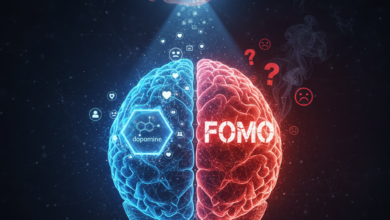Understanding the Rise of Loneliness in Today’s Society

Defining Loneliness: More Than Just a Feeling
Loneliness is often misconceived as simply a feeling of being alone; however, it is a complex emotional experience that can occur even in the presence of others. It is crucial to distinguish loneliness from solitude and social isolation. While solitude might be a chosen state of being alone that can be enjoyed and even beneficial for personal reflection, loneliness is characterized by a profound sense of disconnection and lack of belongingness. This disconnection can stem not only from physical isolation but also from the quality of interpersonal relationships. Social isolation pertains to the objective absence of social connections, whereas loneliness is the subjective experience of feeling disconnected from others, regardless of the number of people surrounding an individual.
The psychological and emotional aspects of loneliness are critical in understanding its impact on individuals and society as a whole. It can manifest in various forms, including chronic loneliness, which persists over an extended period, and situational loneliness, which arises in response to specific life events such as relocation, loss, or transitions in relationships. Each form of loneliness has differing implications for mental health, often contributing to conditions such as depression, anxiety, and decreased overall well-being.
Moreover, the rise of technology and social media in today’s society has created an environment where individuals may feel connected yet remain superficially engaged. This paradox emphasizes the importance of genuine interactions in fostering deep connections and alleviating feelings of loneliness. As loneliness becomes more prevalent, it raises significant concerns regarding its long-term effects on both mental and physical health, underscoring the need for a deeper investigation into its causes and possible solutions. Thus, understanding loneliness not only highlights its significance as a societal issue but also opens the door for further exploration into effective means of intervention and support.
The Impact of Technology on Social Connections
The rapid advancement of technology, particularly in the realm of communication, has significantly reshaped the ways in which individuals interact. While advancements such as social media platforms and instant messaging applications have created avenues for connectivity, they have also contributed to a paradoxical increase in feelings of loneliness. Despite being more connected than ever, many individuals report experiencing a sense of isolation. This phenomenon can largely be attributed to the superficial nature of online interactions.
Online communication often lacks the depth of face-to-face conversations, where non-verbal cues such as body language and tone of voice play a crucial role. Platforms that facilitate chat and quick exchanges can lead to misunderstandings and diminish the emotional richness that is inherent in personal interactions. In this regard, while users may accumulate a vast number of online contacts, the resulting connections often remain shallow, failing to foster genuine intimacy or understanding.
Moreover, the pervasive use of smartphones and social media can create a false sense of belonging. As individuals scroll through curated online personas showcasing idealized lifestyles, they may find themselves feeling inadequate or excluded, leading to an exacerbation of loneliness. The illusion of connection provided by social media can serve to isolate users further, as they engage more with screens than with the people physically present in their lives. This shift in communication norms raises critical concerns about the impact of technology on mental health and well-being.
Ultimately, while technology has the potential to enhance connectivity, it can also complicate the nature of social interactions. The challenge lies in navigating this technological landscape mindfully, ensuring that meaningful human connections are prioritized over the convenience of digital communication.
Societal Changes and Their Role in Increasing Loneliness
The rise of loneliness in contemporary society can be attributed to various societal changes that have profoundly impacted interpersonal connections. One significant factor is urbanization, which has led to the migration of individuals to densely populated cities. While these urban environments offer opportunities for employment and improved living standards, they often strip away the familiarity and support structures of traditional community living. Many individuals find themselves living in close proximity to others, yet they experience increased feelings of isolation due to the lack of meaningful interactions.
Population mobility further exacerbates this issue. With greater access to transportation and digital communication, people are no longer tied to their original communities. While this can foster broader social networks, it often results in transient relationships that lack depth. As individuals frequently move for educational or professional reasons, they may find it challenging to form lasting connections in their new environments. The continuity of friendships and familial relationships frequently suffers, leading to a pervasive sense of loneliness that can become entrenched over time.
Additionally, changes in family structures and dynamics have played a crucial role in the increasing incidence of loneliness. The traditional nuclear family model has evolved, with more individuals living alone or opting for smaller family units. As this shift occurs, the emotional support and companionship typically offered within larger family systems diminish. Moreover, the proliferation of technology has created a paradox where, despite broader access to virtual communication, individuals may prioritize digital interactions over face-to-face engagements, which are essential for developing deep, meaningful relationships.
Modern work lifestyles, characterized by extended hours and heightened pressures, contribute significantly to this phenomenon. Studies reveal that longer working hours leave less time for community-oriented activities, depriving individuals of opportunities to engage socially. Consequently, the decline in neighborhood gatherings and collective events fosters social disconnection and a sense of isolation, increasing overall loneliness in society. Such shifts highlight the complexity of loneliness as an outcome of evolving societal norms and behaviors.
Addressing Loneliness: Solutions and Strategies
Addressing loneliness requires a comprehensive approach that includes both individual strategies and larger societal interventions. On a personal level, individuals can take proactive steps to cultivate connections by engaging in social activities that align with their interests. Joining clubs, volunteering, or participating in community events can foster meaningful relationships and reduce feelings of isolation. Additionally, digital platforms can serve as valuable tools for connection, allowing individuals to engage with others and form online communities that share similar values and interests.
Another effective strategy is to prioritize quality over quantity when it comes to relationships. Fostering deeper connections with a smaller circle of friends can lead to more fulfilling interactions, reducing the overwhelming nature of social demands. Practicing empathy and being present in conversations can further enhance relationships, making individuals feel more connected and understood. Furthermore, adopting routines that promote social engagement, such as setting regular meet-ups with friends or family, can create a consistent support network.
On a broader scale, community initiatives play a crucial role in combating loneliness. Schools, workplaces, and local governments can implement programs that encourage social interaction, such as recreational activities and support groups. Policies that promote inclusivity and accessibility in public spaces can also create environments where social engagement is welcomed and facilitated. Mental health awareness campaigns should be launched to destigmatize loneliness, encouraging those affected to seek help and connect with others.
Ultimately, addressing loneliness is a shared responsibility that requires collaborative efforts from both individuals and communities. By implementing these strategies, society can work towards creating a more connected and compassionate environment for all, significantly reducing feelings of loneliness and isolation.






















